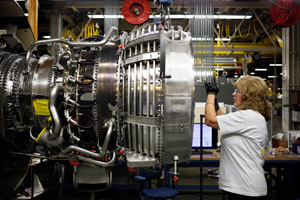Factory Output Declines More Than Forecast in August

Output at American manufacturers fell more than economists forecast in August, a sign the industry is having trouble finding its footing.
The 0.4% decline at factories was the biggest drop since March and followed a 0.4% increase the prior month, a Federal Reserve report showed Sept. 15 in Washington. The Bloomberg News survey median called for a 0.3% drop. Total industrial output, including mines and utilities, dropped 0.4%, also a steeper decline than anticipated.
The data add to concerns sparked last week by a private survey of purchasing managers that showed manufacturing contracted last month. Any slowdown in U.S. or global demand would further worsen the outlook for producers, who are trying to recover from the energy sector pullback, bulging inventories and lingering effects of the dollar’s surge.
“Manufacturing is looking soft,” said Scott Brown, St. Petersburg, Florida-based chief economist for Raymond James Financial Inc., who correctly projected the drop in factory output. “We expect more of the same the rest of the year. The weakness in capital investment is a global phenomenon.”
The latest results are consistent with the Institute for Supply Management’s factory survey for August, which signaled a contraction, albeit for the first time in six months. Orders plunged, production was cut by the most since 2012 and employment fell, that report showed.
Manufacturing, which makes up 75% of total industrial production, accounts for about 12% of the U.S. economy. Fed officials, meeting next week, are weighing economic data to determine when to raise interest rates.
One bright spot in the report was that oil and gas well drilling rose 3.2%, the third straight monthly gain. That provides “a ray of light here,” Brown said.
Economists’ estimates for factory output in the Bloomberg survey ranged from a decline of 0.5% to an advance of 0.4%. The previous month’s reading was revised from a 0.5% gain.
For total industrial production, the Bloomberg survey median called for a 0.2% decrease. The prior month was revised to a 0.6% increase after a previously reported 0.7% advance.
Utility output fell 1.4% in August, the biggest decrease since March, after rising 2.1% the previous month, the Fed report showed.
Mining production, which includes oil drilling, increased 1%, the fourth straight monthly gain that reflects stabilization in the price of oil and other commodities.
Capacity utilization, which measures the amount of a plant that is in use, dropped to 75.5% from 75.9% in the prior month.
The output of motor vehicles and parts increased 0.5% after a 1% gain a month earlier. Excluding autos and parts, manufacturing output declined 0.5% after increasing 0.3% the prior month.
Machinery production dropped 1.9%, and output of computers and electronics gained 1%. Construction materials fell 0.6%. Consumer goods production declined 0.2%, while output of business equipment decreased 0.4%.



